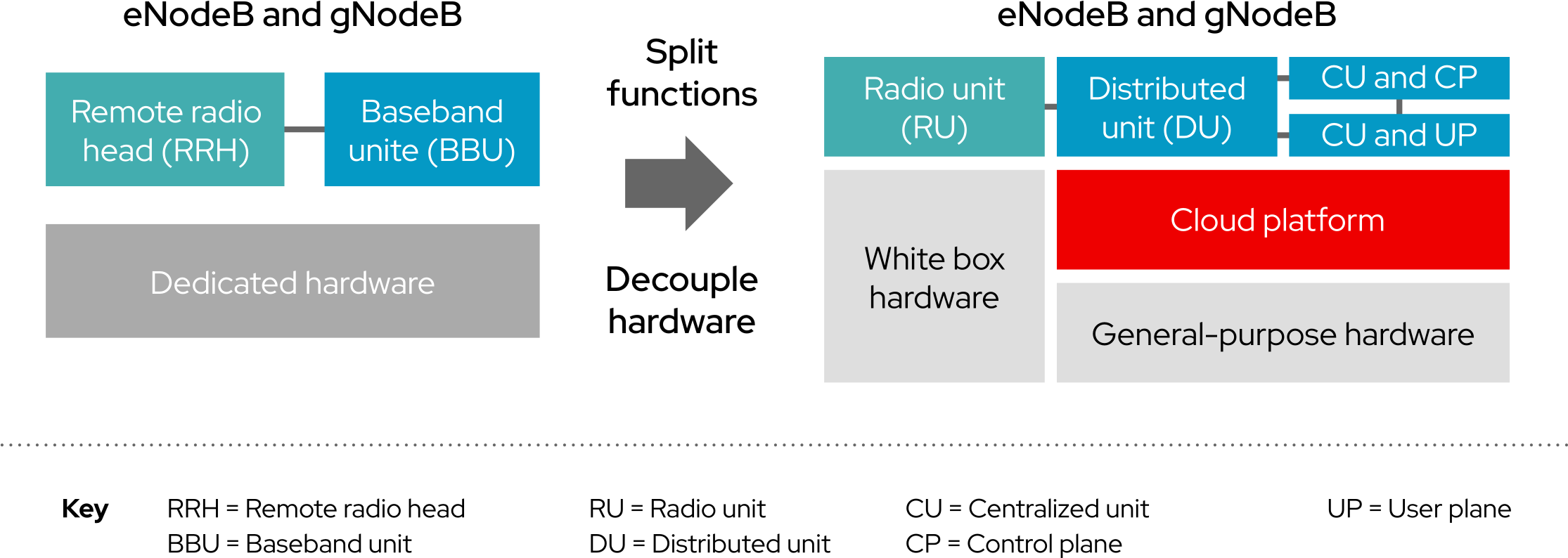Virtualize radio access networks for more agility and choice
The current radio access network (RAN) market is highly concentrated with only a few suppliers offering closed products that third parties cannot access. This reduces competition and access to RAN data and delays network service innovation because network operators must rely on suppliers’ development cycles and life-cycle management.
Open supply chains create better virtual RAN solutions
Software-defined architectures are disrupting the supply chain for mobile network infrastructures, with massive economic impact on RANs as they scale to handle the growing volume of mobile traffic and the huge growth expected from new 5G use cases.
Communications service providers (CSPs) can innovate faster and deliver more versatile RAN functions by adopting virtualization and disaggregation technologies based on open industry standards like O-RAN and Telecom Infra Project (TIP) OpenRAN.
Horizontal cloud-native foundation
Disaggregating and virtualizing baseband units (BBU) into virtual central units (vCU) and virtual distributed units (vDU) allows CSPs to decouple BBU function from the underlying hardware. They can deliver these functions on general purpose hardware at aggregation centers or central offices as a software fabric that makes scaling capacity, automating workflows, and managing the solution life cycle more effective and efficient.
Virtualizing and disaggregating RAN gives CSPs the freedom to work with new suppliers, boost innovation and differentiation, and utilize new operating models.
A more secure horizontal cloud platform spanning RAN, mobile core, and other functions creates synergies in engineering, security, and operations.
Use automation across a telecommunications cloud to accelerate new service deployment.
Network planning, management, and orchestration become more efficient and resource productivity increases when the same cloud environment is horizontally extended across the RAN, mobile core, and other functions.
Agile infrastructure for streamlined operations and greater flexibility
Flexible and scalable RAN services delivered on automated platforms enable faster time to market and simplified workflows, ensuring repeatability and maintainability. Open virtual architectures bring together interoperable components from a wider spectrum of suppliers and connect them via standard interfaces. This approach makes it easy to deploy redundant instances, scale efficiently, and improve isolation for services like network slicing. Open virtual RAN allows for zero-touch provisioning and automates fault detection and remediation using common tools and interfaces.
Software-centric RAN solutions increase programmability, and, when combined with intent-based orchestration, they can deliver nearly complete workflow automation. CSPs can increase service agility and help grow new services faster.
30% lower total cost of ownership than vertically integrated solutions.
Red Hat provides a more secure framework for an open ecosystem
Red Hat delivers a cloud platform for radio vendors, network equipment providers (NEPs), and system integrators to offer a complete virtual RAN solution in an open ecosystem. Built on the open source foundation of Red Hat® Enterprise Linux®, Red Hat OpenShift® Container Platform, Red Hat OpenStack® Platform, and Red Hat Ansible® Automation Platform, it is easier to deploy and operate.
With Red Hat, service providers can deploy cloud RAN either as container-based or virtual machine-based functions, or both. Container-based, cloud-native designs using Red Hat OpenShift can offer additional benefits, including launching new services faster, reducing maintenance, and reducing required compute resources.
RAN services demand real-time capabilities and time-synchronization requirements from network infrastructures. Red Hat Enterprise Linux provides a consistent foundation and deterministic timing with real-time kernel, hardware acceleration with field programmable gate arrays (FPGA), graphic processing units (GPUs), and smart network interface cards (NICs), and support for precision time protocols (PTP).
Red Hat cloud platforms offer security at multiple layers. Security-Enhanced Linux® (SELinux) offers access controls, crypto policies, and offload. Red Hat OpenShift offers network isolation, identity and access management, and integrated secrets management.
Get started
Learn more about Red Hat telco solutions.

